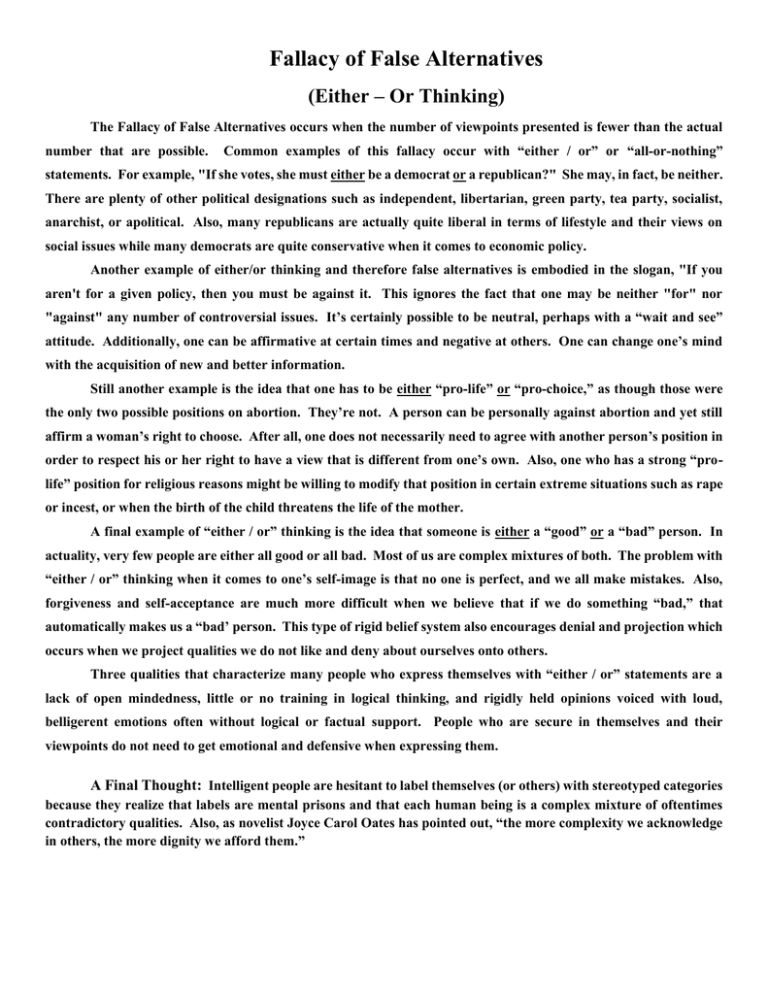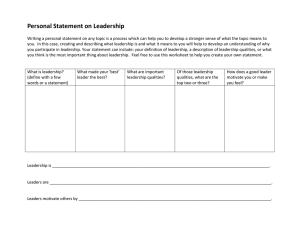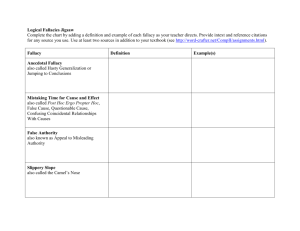Fallacy of False Alternatives.docx
advertisement

Fallacy of False Alternatives (Either – Or Thinking) The Fallacy of False Alternatives occurs when the number of viewpoints presented is fewer than the actual number that are possible. Common examples of this fallacy occur with “either / or” or “all-or-nothing” statements. For example, "If she votes, she must either be a democrat or a republican?" She may, in fact, be neither. There are plenty of other political designations such as independent, libertarian, green party, tea party, socialist, anarchist, or apolitical. Also, many republicans are actually quite liberal in terms of lifestyle and their views on social issues while many democrats are quite conservative when it comes to economic policy. Another example of either/or thinking and therefore false alternatives is embodied in the slogan, "If you aren't for a given policy, then you must be against it. This ignores the fact that one may be neither "for" nor "against" any number of controversial issues. It’s certainly possible to be neutral, perhaps with a “wait and see” attitude. Additionally, one can be affirmative at certain times and negative at others. One can change one’s mind with the acquisition of new and better information. Still another example is the idea that one has to be either “pro-life” or “pro-choice,” as though those were the only two possible positions on abortion. They’re not. A person can be personally against abortion and yet still affirm a woman’s right to choose. After all, one does not necessarily need to agree with another person’s position in order to respect his or her right to have a view that is different from one’s own. Also, one who has a strong “prolife” position for religious reasons might be willing to modify that position in certain extreme situations such as rape or incest, or when the birth of the child threatens the life of the mother. A final example of “either / or” thinking is the idea that someone is either a “good” or a “bad” person. In actuality, very few people are either all good or all bad. Most of us are complex mixtures of both. The problem with “either / or” thinking when it comes to one’s self-image is that no one is perfect, and we all make mistakes. Also, forgiveness and self-acceptance are much more difficult when we believe that if we do something “bad,” that automatically makes us a “bad’ person. This type of rigid belief system also encourages denial and projection which occurs when we project qualities we do not like and deny about ourselves onto others. Three qualities that characterize many people who express themselves with “either / or” statements are a lack of open mindedness, little or no training in logical thinking, and rigidly held opinions voiced with loud, belligerent emotions often without logical or factual support. People who are secure in themselves and their viewpoints do not need to get emotional and defensive when expressing them. A Final Thought: Intelligent people are hesitant to label themselves (or others) with stereotyped categories because they realize that labels are mental prisons and that each human being is a complex mixture of oftentimes contradictory qualities. Also, as novelist Joyce Carol Oates has pointed out, “the more complexity we acknowledge in others, the more dignity we afford them.” Examples of “Either / Or” and “Both / And” Thinking Either / Or People are either Good or Bad Both / And People are both Good and Bad _________________________________________________________________ Meaning is Literal: Meaning is Metaphoric: There is one truth. There are many truths. Truth is multi-dimensional with different levels and interpretations. You are either right or wrong, either stupid or smart, a winner or a loser. You are both right and wrong, both smart and stupid, a winner and a loser. Example from real life: My boyfriend: is a jerk is lovable and sometimes a jerk

